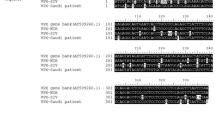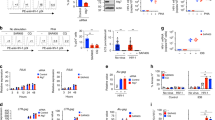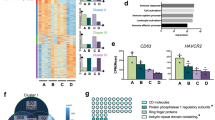Abstract
Viruses have developed diverse non-immune strategies to counteract host-mediated mechanisms that confer resistance to infection. The Vif (virion infectivity factor) proteins are encoded by primate immunodeficiency viruses, most notably human immunodeficiency virus-1 (HIV-1). These proteins are potent regulators of virus infection and replication and are consequently essential for pathogenic infections in vivo1,2,3,4,5,6. HIV-1 Vif seems to be required during the late stages of virus production3,6 for the suppression of an innate antiviral phenotype that resides in human T lymphocytes7,8. Thus, in the absence of Vif, expression of this phenotype renders progeny virions non-infectious. Here, we describe a unique cellular gene, CEM15, whose transient or stable expression in cells that do not normally express CEM15 recreates this phenotype, but whose antiviral action is overcome by the presence of Vif. Because the Vif:CEM15 regulatory circuit is critical for HIV-1 replication, perturbing the circuit may be a promising target for future HIV/AIDS therapies.
This is a preview of subscription content, access via your institution
Access options
Subscribe to this journal
Receive 51 print issues and online access
$199.00 per year
only $3.90 per issue
Buy this article
- Purchase on SpringerLink
- Instant access to full article PDF
Prices may be subject to local taxes which are calculated during checkout






Similar content being viewed by others
References
Desrosiers, R. C. et al. Identification of highly attenuated mutants of simian immunodeficiency virus. J. Virol. 72, 1431–1437 (1998)
Fisher, A. G. et al. The sor gene of HIV-1 is required for efficient virus transmission in vitro. Science 237, 888–893 (1987)
Gabuzda, D. H. et al. Role of vif in replication of human immunodeficiency virus type 1 in CD4+ T lymphocytes. J. Virol. 66, 6489–6495 (1992)
Simon, J. H. M. et al. The regulation of primate immunodeficiency virus infectivity by Vif is cell species restricted: a role for Vif in determining virus host range and cross-species transmission. EMBO J. 17, 1259–1267 (1998)
Strebel, K. et al. The HIV “A” (sor) gene product is essential for virus infectivity. Nature 328, 728–730 (1987)
von Schwedler, U., Song, J., Aiken, C. & Trono, D. vif is crucial for human immunodeficiency virus type 1 proviral DNA synthesis in infected cells. J. Virol. 67, 4945–4955 (1993)
Madani, N. & Kabat, D. An endogenous inhibitor of human immunodeficiency virus in human lymphocytes is overcome by the viral Vif protein. J. Virol. 72, 10251–10255 (1998)
Simon, J. H. M., Gaddis, N. C., Fouchier, R. A. M. & Malim, M. H. Evidence for a newly discovered cellular anti-HIV-1 phenotype. Nature Med. 4, 1397–1400 (1998)
Foley, G. E. et al. Loss of neoplastic properties in vitro. II. Observations on KB sublines. Cancer Res. 25, 1254–1261 (1965)
Nara, P. L. & Fischinger, P. J. Quantitative infectivity assay for HIV-1 and -2. Nature 332, 469–470 (1988)
Hassaine, G. et al. The tyrosine kinase Hck is an inhibitor of HIV-1 replication counteracted by the viral vif protein. J. Biol. Chem. 276, 16885–16893 (2001)
Camaur, D. & Trono, D. Characterization of human immunodeficiency virus type 1 Vif particle incorporation. J. Virol. 70, 6106–6111 (1996)
Fouchier, R. A. M., Simon, J. H. M., Jaffe, A. B. & Malim, M. H. Human immunodeficiency virus type 1 Vif does not influence expression or virion incorporation of gag-, pol-, and env-encoded proteins. J. Virol. 70, 8263–8269 (1996)
Liu, H. et al. The Vif protein of human and simian immunodeficiency viruses is packaged into virions and associates with viral core structures. J. Virol. 69, 7630–7638 (1995)
Teng, B., Burant, C. F. & Davidson, N. O. Molecular cloning of an apolipoprotein B messenger RNA editing protein. Science 26, 1816–1819 (1993)
Madsen, P. et al. Psoriasis upregulated phorbolin-1 shares structural but not functional similarity to the mRNA-editing protein apobec-1. J. Invest. Dermatol. 113, 162–169 (1999)
Bhattacharya, S., Navaratnam, N., Morrison, J. R., Scott, J. & Taylor, W. R. Cytosine nucleoside/nucleotide deaminases and apolipoprotein B mRNA editing. Trends Biochem. Sci. 19, 105–106 (1994)
MacGinnitie, A. J., Anant, S. & Davidson, N. O. Mutagenesis of apobec-1, the catalytic subunit of the mammalian apolipoprotein B mRNA editing enzyme, reveals distinct domains that mediate cytosine nucleoside deaminase, RNA binding, and RNA editing activity. J. Biol. Chem. 270, 14768–14775 (1995)
Smith, A. A., Carlow, D. C., Wolfenden, R. & Short, S. A. Mutations affecting transition-state stabilization by residues coordinating zinc at the active site of cytidine deaminase. Biochemistry 33, 6468–6474 (1994)
Dettenhofer, M., Cen, S., Carlson, B. A., Kleiman, L. & Yu, X.-F. Association of human immunodeficiency virus type 1 Vif with RNA and its role in reverse transcription. J. Virol. 74, 8938–8945 (2000)
Khan, M. A. et al. Human immunodeficiency virus type 1 Vif protein is packaged into the nucleoprotein complex through an interaction with viral genomic RNA. J. Virol. 75, 7252–7265 (2001)
Zhang, H., Pomerantz, R. J., Dornadula, G. & Sun, Y. Human immunodeficiency virus type 1 Vif protein is an integral component of an mRNP complex of viral RNA and could be involved in the viral RNA folding and packaging process. J. Virol. 74, 8252–8261 (2000)
Courcoul, M. et al. Peripheral blood mononuclear cells produce normal amounts of defective Vif- human immunodeficiency virus type 1 particle which are restricted for the preretrotranscription steps. J. Virol. 69, 2068–2074 (1995)
Simon, J. H. M. & Malim, M. H. The human immunodeficiency virus type 1 Vif protein modulates the postpenetration stability of viral nucleoprotein complexes. J. Virol. 70, 5297–5305 (1996)
Sova, P. & Volsky, D. J. Efficiency of viral DNA synthesis during infection of permissive and nonpermissive cells with vif-negative human immunodeficiency virus type 1. J. Virol. 67, 6322–6326 (1993)
Pryciak, P. M. & Varmus, H. E. Fv-1 restriction and its effects on murine leukemia virus integration in vivo and in vitro. J. Virol. 66, 5959–5966 (1992)
Towers, G. et al. A conserved mechanism of retrovirus restriction in mammals. Proc. Natl Acad. Sci. USA 97, 12295–12299 (2000)
Fouchier, R. A. M., Meyer, B. E., Simon, J. H. M., Fischer, U. & Malim, M. H. HIV-1 infection of non-dividing cells: evidence that the amino-terminal basic region of the viral matrix protein is important for Gag processing but not for post-entry nuclear import. EMBO J. 16, 4531–4539 (1997)
Pear, W. S. et al. Efficient and rapid induction of a chronic myelogenous leukemia-like myeloproliferative disease in mice receiving P210 bcr/abl-transduced bone marrow. Blood 92, 3780–3792 (1998)
Simon, J. H. M. et al. The Vif and Gag proteins of human immunodeficiency virus type 1 colocalize in infected human T cells. J. Virol. 71, 5259–5267 (1997)
Acknowledgements
We thank D. Gabuzda for the CEM cells. This work was supported by Research Grants from the National Institutes of Health (M.H.M. and A.M.S.), the National Science Foundation (N.C.G.) and the UK Medical Research Council (M.H.M.). M.H.M. is an Elizabeth Glaser Scientist supported by the Elizabeth Glaser Pediatric AIDS Foundation.
Author information
Authors and Affiliations
Corresponding author
Ethics declarations
Competing interests
The authors declare that they have no competing financial interests.
Rights and permissions
About this article
Cite this article
Sheehy, A., Gaddis, N., Choi, J. et al. Isolation of a human gene that inhibits HIV-1 infection and is suppressed by the viral Vif protein. Nature 418, 646–650 (2002). https://doi.org/10.1038/nature00939
Received:
Accepted:
Published:
Issue Date:
DOI: https://doi.org/10.1038/nature00939
This article is cited by
-
Antiretroviral APOBEC3 cytidine deaminases alter HIV-1 provirus integration site profiles
Nature Communications (2023)
-
TRIM26 positively affects hepatitis B virus replication by inhibiting proteasome-dependent degradation of viral core protein
Scientific Reports (2023)
-
Structural basis of HIV-1 Vif-mediated E3 ligase targeting of host APOBEC3H
Nature Communications (2023)
-
The KT Jeang Retrovirology prize 2022: Florence Margottin-Goguet
Retrovirology (2022)
-
The coevolution between APOBEC3 and retrotransposons in primates
Mobile DNA (2022)



